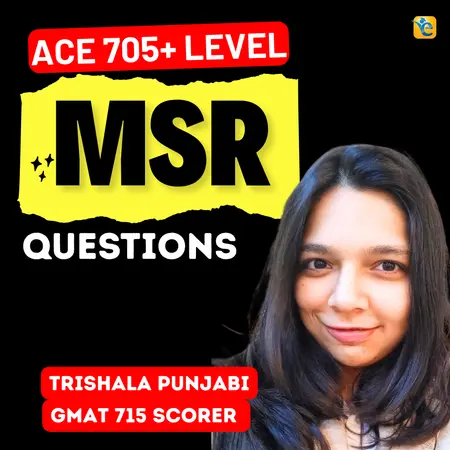Events & Promotions
|
|

GMAT Club Daily Prep
Thank you for using the timer - this advanced tool can estimate your performance and suggest more practice questions. We have subscribed you to Daily Prep Questions via email.
Customized
for You
Track
Your Progress
Practice
Pays
Not interested in getting valuable practice questions and articles delivered to your email? No problem, unsubscribe here.
- Nov 18
11:00 AM PST
-12:00 PM PST
Join us in a live GMAT practice session and solve 30 challenging GMAT questions with other test takers in timed conditions, covering GMAT Quant, Data Sufficiency, Data Insights, Reading Comprehension, and Critical Reasoning questions. - Nov 22
11:00 AM IST
-01:00 PM IST
Do RC/MSR passages scare you? e-GMAT is conducting a masterclass to help you learn – Learn effective reading strategies Tackle difficult RC & MSR with confidence Excel in timed test environment - Nov 23
11:00 AM IST
-01:00 PM IST
Attend this free GMAT Algebra Webinar and learn how to master the most challenging Inequalities and Absolute Value problems with ease. - Nov 25
10:00 AM EST
-11:00 AM EST
Prefer video-based learning? The Target Test Prep OnDemand course is a one-of-a-kind video masterclass featuring 400 hours of lecture-style teaching by Scott Woodbury-Stewart, founder of Target Test Prep and one of the most accomplished GMAT instructors.
Kudos
Bookmarks
First error: $160.02
Second error: $317.43
Be sure to select an answer first to save it in the Error Log before revealing the correct answer (OA)!
Difficulty:
 95%
(hard)
95%
(hard)
Question Stats:
57% (03:12) correct 43%
(03:30)
wrong
43%
(03:30)
wrong  based on 939
sessions
based on 939
sessions
History
Date
Time
Result
Not Attempted Yet
A financial adviser was showing a client the value, rounded to the nearest cent, of an initial investment of $100.00 after 5, 10, 15, 20, 25, and 30 years, under the assumption that the value increases by r% per year for some positive constant r. The adviser correctly gave $130.01 for the value after 5 years. However, the adviser inadvertently made two transcription errors, and as a result, two of the remaining values shown to the client were incorrect.
Assuming the options provided are the remaining five amounts shown to the client, select for First error the lesser of the two incorrectly transcribed values and select for Second error the greater of the two incorrectly transcribed values. Make only two selections, one in each column.
Assuming the options provided are the remaining five amounts shown to the client, select for First error the lesser of the two incorrectly transcribed values and select for Second error the greater of the two incorrectly transcribed values. Make only two selections, one in each column.
ID: 700234
| First error | Second error | |
| $160.02 | ||
| $219.75 | ||
| $285.70 | ||
| $317.43 | ||
| $482.90 |
ShowHide Answer
Official Answer
First error: $160.02
Second error: $317.43
Kudos
Bookmarks
apoorvmht
So, we are looking at compound interest at r% per year.
Finding r here would be cumbersome, So, let us take rate of interest as R for a time period of 5 years as we are talking of amount after every five years.
So, if time period is 5 years, the R is \(\frac{130.01-100}{100}*100\) or 30.01%
10 years: After another 5 years, amount will become \(130.01*(1+\frac{30.01}{100})=130.01*1.3001\)~\(169\neq 160\)
15 years: After another 5 years, amount will become \(169*(1+\frac{30.01}{100})=169*1.3001\)~\(219\)
20 years: After another 5 years, amount will become \(219*(1+\frac{30.01}{100})=219*1.3001\)~\(285\)
25 years: After another 5 years, amount will become \(285*(1+\frac{30.01}{100})=285*1.3001\)~\(371\neq 317\)
30 years: After another 5 years, amount will become \(371*(1+\frac{30.01}{100})=371*1.3001\)~\(482\)
The values are 160 and 317
Mathematically
CI formula \(P(1+\frac{r}{100})^t=Amount\)
\(100(1+\frac{r}{100})^5=130.01\)
\((1+\frac{r}{100})^5=1.3001\)
After 10 years: \(100(1+\frac{r}{100})^10\)
\(100((1+\frac{r}{100})^5)^2=130.01*(1+\frac{r}{100})^5=130.01*1.3001\)
And so on
Kudos
Bookmarks
The first error is $160.02 and the second error is $317.43.
Since the amount is $130.01 after 5 years, r = 30.01%
--> After 10 years = 130.01 * 1.3001 = $169.03 (incorrect)
--> After 15 years = 169.03 * 1.3001 = $219.75
--> After 20 years = 219.75 * 1.3001 = $285.70
--> After 25 years = 285.70 * 1.3001 = $371.44 (incorrect)
--> After 30 years = 371.44 * 1.3001 = $482.90
Since the amount is $130.01 after 5 years, r = 30.01%
--> After 10 years = 130.01 * 1.3001 = $169.03 (incorrect)
--> After 15 years = 169.03 * 1.3001 = $219.75
--> After 20 years = 219.75 * 1.3001 = $285.70
--> After 25 years = 285.70 * 1.3001 = $371.44 (incorrect)
--> After 30 years = 371.44 * 1.3001 = $482.90














